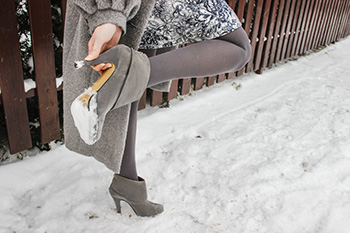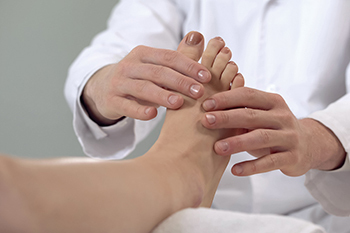Connect With Us
Blog
Items filtered by date: September 2022
Frequent High Heel Use May Cause Foot Conditions

People who frequently wear high heels may not realize the dangers that coincide, beginning with an increase in tripping hazards. Additionally, high heels may significantly contribute to incurring a foot or ankle injury, and circulation may be negatively affected, too. Some of the foot conditions that can gradually develop from wearing high heels include Achilles tendonitis, bunions, hammertoes, blisters, corns, and calluses. The body’s weight can be affected by leaning forward as a result of the shape of the shoe and this can cause the weight to shift to the balls of the feet. Some measures can be implemented that can provide comfort while wearing high heels. These can include choosing a lower heel, wearing them less often during the week, and stretching the feet and ankles as often as possible. Podiatrists can answer any questions you may have regarding how high heels can affect the feet, and it is suggested that you consult with this type of doctor if you would like more information.
High heels have a history of causing foot and ankle problems. If you have any concerns about your feet or ankles, contact Thi Pham, DPM from Foot Specialists of Tri-County. Our doctor can provide the care you need to keep you pain-free and on your feet.
Effects of High Heels on the Feet
High heels are popular shoes among women because of their many styles and societal appeal. Despite this, high heels can still cause many health problems if worn too frequently.
Which Parts of My Body Will Be Affected by High Heels?
- Ankle Joints
- Achilles Tendon – May shorten and stiffen with prolonged wear
- Balls of the Feet
- Knees – Heels cause the knees to bend constantly, creating stress on them
- Back – They decrease the spine’s ability to absorb shock, which may lead to back pain. The vertebrae of the lower back may compress.
What Kinds of Foot Problems Can Develop from Wearing High Heels?
- Corns
- Calluses
- Hammertoe
- Bunions
- Morton’s Neuroma
- Plantar Fasciitis
How Can I Still Wear High Heels and Maintain Foot Health?
If you want to wear high heeled shoes, make sure that you are not wearing them every day, as this will help prevent long term physical problems. Try wearing thicker heels as opposed to stilettos to distribute weight more evenly across the feet. Always make sure you are wearing the proper shoes for the right occasion, such as sneakers for exercising. If you walk to work, try carrying your heels with you and changing into them once you arrive at work. Adding inserts to your heels can help cushion your feet and absorb shock. Full foot inserts or metatarsal pads are available.
If you have any questions please feel free to contact our offices located in Sulphur Springs, Winnsboro, and Pittsburg, TX . We offer the newest diagnostic and treatment technologies for all your foot and ankle needs.
Heel Spurs May or May Not Cause Pain

Heel spurs are small, bony growths on the heel of the foot. A spur may grow when the plantar fascia ligament that connects the heel bones to the toe bones become inflamed. The inflammation from a heel spur might cause discomfort or not. If it does hurt, there will be pain or tenderness over the weight-bearing part of the bottom of the heel. A bump can sometimes be felt when the area is touched. A spur will not be treated unless other conditions caused by inflammation causing the pain are non-existent. For example, plantar fasciitis may be the main source of pain, and that condition will be treated and the bone spur left alone. If you have a bone spur and pain, see a podiatrist to find out the source of pain so you can receive appropriate treatment options.
Heel spurs can be incredibly painful and sometimes may make you unable to participate in physical activities. To get medical care for your heel spurs, contact Thi Pham, DPM from Foot Specialists of Tri-County. Our doctor will do everything possible to treat your condition.
Heels Spurs
Heel spurs are formed by calcium deposits on the back of the foot where the heel is. This can also be caused by small fragments of bone breaking off one section of the foot, attaching onto the back of the foot. Heel spurs can also be bone growth on the back of the foot and may grow in the direction of the arch of the foot.
Older individuals usually suffer from heel spurs and pain sometimes intensifies with age. One of the main condition's spurs are related to is plantar fasciitis.
Pain
The pain associated with spurs is often because of weight placed on the feet. When someone is walking, their entire weight is concentrated on the feet. Bone spurs then have the tendency to affect other bones and tissues around the foot. As the pain continues, the feet will become tender and sensitive over time.
Treatments
There are many ways to treat heel spurs. If one is suffering from heel spurs in conjunction with pain, there are several methods for healing. Medication, surgery, and herbal care are some options.
If you have any questions feel free to contact our offices located in Sulphur Springs, Winnsboro, and Pittsburg, TX . We offer the latest in diagnostic and treatment technology to meet your needs.
Ankle Pain at Night
Foot pain, no matter when it occurs during the day, can be uncomfortable and unpleasant. While it is common for individuals suffering from conditions like plantar fasciitis to experience foot pain at the very beginning of the day, others experience foot pain at night. For example, it is possible to experience ankle pain during the night, and can happen for several reasons. First, tarsal tunnel syndrome can create pain that's worse at night. When nerves in your ankle become compressed and pinched, tarsal tunnel syndrome can develop. Individuals can experience pain not just in the ankles but also numbness and discomfort on the soles of the feet. Since the pressure on these nerves is most potent at night, the pain is typically more acute at this time. If you experience ankle pain at night, it may be caused by nighttime foot cramps. Comparable to the nocturnal leg cramps that usually affect the calves, foot cramps work similarly and can cause shooting pains in the feet. Sometimes, foot cramps can create pain that travels up to the ankle. If you have pain in your ankle that is more noticeable at night, contact a podiatrist to help address the problem.
Ankle pain can be caused by a number of problems and may be potentially serious. If you have ankle pain, consult with Thi Pham, DPM from Foot Specialists of Tri-County. Our doctor will assess your condition and provide you with quality foot and ankle treatment.
Ankle pain is any condition that causes pain in the ankle. Due to the fact that the ankle consists of tendons, muscles, bones, and ligaments, ankle pain can come from a number of different conditions.
Causes
The most common causes of ankle pain include:
- Types of arthritis (rheumatoid, osteoarthritis, and gout)
- Ankle sprains
- Broken ankles
- Achilles tendinitis
- Achilles tendon rupture
- Stress fractures
- Bursitis
- Tarsal tunnel syndrome
- Plantar fasciitis
Symptoms
Symptoms of ankle injury vary based upon the condition. Pain may include general pain and discomfort, swelling, aching, redness, bruising, burning or stabbing sensations, and/or loss of sensation.
Diagnosis
Due to the wide variety of potential causes of ankle pain, podiatrists will utilize a number of different methods to properly diagnose ankle pain. This can include asking for personal and family medical histories and of any recent injuries. Further diagnosis may include sensation tests, a physical examination, and potentially x-rays or other imaging tests.
Treatment
Just as the range of causes varies widely, so do treatments. Some more common treatments are rest, ice packs, keeping pressure off the foot, orthotics and braces, medication for inflammation and pain, and surgery.
If you have any questions, please feel free to contact our offices located in Sulphur Springs, Winnsboro, and Pittsburg, TX . We offer the newest diagnostic and treatment technologies for all your foot care needs.
Bunion Formation

There are a number of foot conditions that you may encounter at one point during your lifetime. Some of them involve the formation of certain abnormal bony protrusions that can cause pain or discomfort. One such foot condition involving a bony protrusion is known as a bunion. Bunions typically develop on the side of the big toe, and in some cases, bunionettes might form on the smallest toe. Since bunions can be an annoyance to those afflicted by them, bunion formation and its causes are of the utmost importance. Bunions are commonly caused by ill-fitting footwear that makes the toes crowd together. Whenever an individual puts a significant amount of pressure on their big toe joint for an extended period of time, this can also potentially lead to bunion formation. Having other conditions or diseases might also lead to bunion formation. For example, having rheumatoid arthritis, cerebral palsy, and Down syndrome makes one particularly vulnerable to developing a bunion. After a bunion forms, it can cause soreness at the affected area or even swelling around the big toe joint. If you believe that you might be at risk of developing a bunion, contact a podiatrist who can help you either prevent or treat a bunion.
If you are suffering from bunion pain, contact Thi Pham, DPM of Foot Specialists of Tri-County. Our doctor can provide the care you need to keep you pain-free and on your feet.
What Is a Bunion?
Bunions are painful bony bumps that usually develop on the inside of the foot at the joint of the big toe. As the deformity increases over time, it may become painful to walk and wear shoes. Women are more likely to exacerbate existing bunions since they often wear tight, narrow shoes that shift their toes together. Bunion pain can be relieved by wearing wider shoes with enough room for the toes.
Causes
- Genetics – some people inherit feet that are more prone to bunion development
- Inflammatory Conditions - rheumatoid arthritis and polio may cause bunion development
Symptoms
- Redness and inflammation
- Pain and tenderness
- Callus or corns on the bump
- Restricted motion in the big toe
In order to diagnose your bunion, your podiatrist may ask about your medical history, symptoms, and general health. Your doctor might also order an x-ray to take a closer look at your feet. Nonsurgical treatment options include orthotics, padding, icing, changes in footwear, and medication. If nonsurgical treatments don’t alleviate your bunion pain, surgery may be necessary.
If you have any questions, please feel free to contact our offices located in Sulphur Springs, Winnsboro, and Pittsburg, TX . We offer the newest diagnostic and treatment technologies for all your foot care needs.


